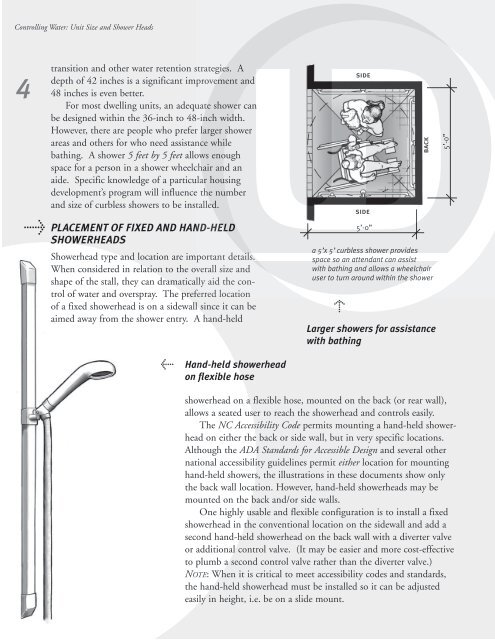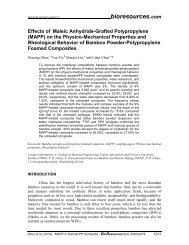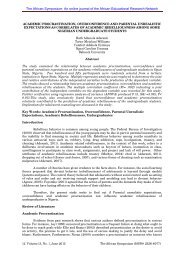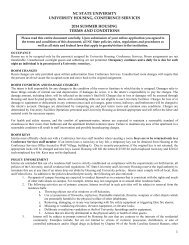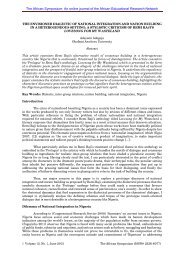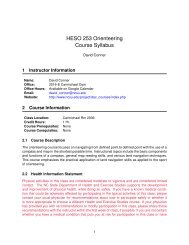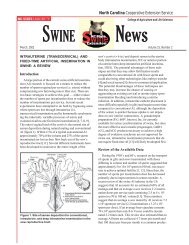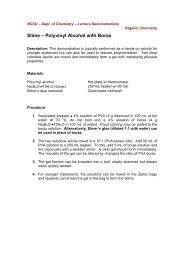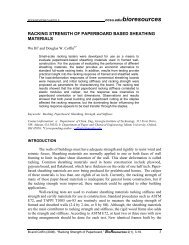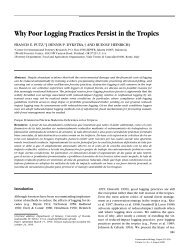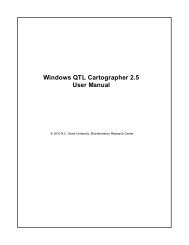Curbless Showers - North Carolina State University
Curbless Showers - North Carolina State University
Curbless Showers - North Carolina State University
Create successful ePaper yourself
Turn your PDF publications into a flip-book with our unique Google optimized e-Paper software.
Controlling Water: Unit Size and Shower Heads<br />
4<br />
><br />
transition and other water retention strategies. A<br />
depth of 42 inches is a significant improvement and<br />
48 inches is even better.<br />
For most dwelling units, an adequate shower can<br />
be designed within the 36-inch to 48-inch width.<br />
However, there are people who prefer larger shower<br />
areas and others for who need assistance while<br />
bathing. A shower 5 feet by 5 feet allows enough<br />
space for a person in a shower wheelchair and an<br />
aide. Specific knowledge of a particular housing<br />
development’s program will influence the number<br />
and size of curbless showers to be installed.<br />
PLACEMENT OF FIXED AND HAND-HELD<br />
SHOWERHEADS<br />
Showerhead type and location are important details.<br />
When considered in relation to the overall size and<br />
shape of the stall, they can dramatically aid the control<br />
of water and overspray. The preferred location<br />
of a fixed showerhead is on a sidewall since it can be<br />
aimed away from the shower entry. A hand-held<br />
><br />
Hand-held showerhead<br />
on flexible hose<br />
a 5’x 5’ curbless shower provides<br />
space so an attendant can assist<br />
with bathing and allows a wheelchair<br />
user to turn around within the shower<br />
><br />
side<br />
side<br />
5’-0”<br />
Larger showers for assistance<br />
with bathing<br />
showerhead on a flexible hose, mounted on the back (or rear wall),<br />
allows a seated user to reach the showerhead and controls easily.<br />
The NC Accessibility Code permits mounting a hand-held showerhead<br />
on either the back or side wall, but in very specific locations.<br />
Although the ADA Standards for Accessible Design and several other<br />
national accessibility guidelines permit either location for mounting<br />
hand-held showers, the illustrations in these documents show only<br />
the back wall location. However, hand-held showerheads may be<br />
mounted on the back and/or side walls.<br />
One highly usable and flexible configuration is to install a fixed<br />
showerhead in the conventional location on the sidewall and add a<br />
second hand-held showerhead on the back wall with a diverter valve<br />
or additional control valve. (It may be easier and more cost-effective<br />
to plumb a second control valve rather than the diverter valve.)<br />
NOTE: When it is critical to meet accessibility codes and standards,<br />
the hand-held showerhead must be installed so it can be adjusted<br />
easily in height, i.e. be on a slide mount.<br />
back<br />
5’-0”


